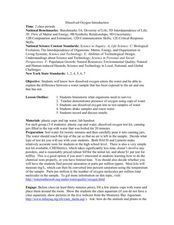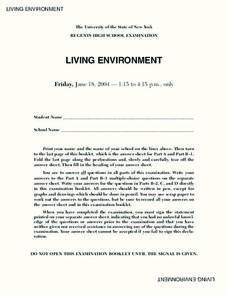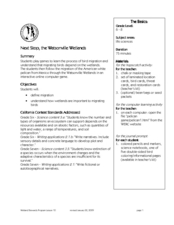Biology Junction
Introduction to Biology Crossword
In this introduction to biology, high schoolers complete a crossword puzzle with 22 questions. They identify common terminologies used in the study of biology.
Kenan Fellows
Determining Stream Health by the Diversity and Types of Benthic Organisms
How diverse are the benthic organisms found in local streams? Using the information learned in previous lessons on identification of macroinvertebrates and on calculating stream index values, groups determine the health of local streams....
Curated OER
HABITAT for the other 90%
Learners examine the connection between the habitat needs of endemic species to the habitat needs of humans. In this habitat lesson students research the habitat requirements of a given family then develop an idea to improve the habitat...
Curated OER
Dissolved Oxygen Introduction
Students are shown how dissolved oxygen enters the water. They are taught the difference between a water sample that has been exposed to the air and one that has not. Students brainstorm what organisms need to survive. They use dissolved...
Curated OER
Basic Needs of Living Things - Lesson One
An interesting way of teaching about basic needs of different organisms awaits your fourth graders. Pupils take part in class discussions and demonstrations which should lead to a greater understanding of how to determine basic needs. As...
Curated OER
Classification Scheme
Fourth graders discuss different classification schemes for living organisms. They group common household items to discover many ways to classify organisms. Students compare/contrast characteristics of each classification.
Curated OER
Food Chain
Third graders role-play various organisms from a food chain to illustrate how a food chain works. In relay style, 3rd graders fill their cups (stomachs) and, in turn, fill a larger organism's cup (stomach) to visualize the importance of...
Curated OER
What A Tangled Web We Weave
Learners of many ages discuss how all organisms rely on other organisms for their survival. They construct a food web and energy pyramids, and write an informative essay about the food web that they have designed.
Curated OER
Keys and Webs
Students explore and classify organisms found in a Rocky Mountain Ecosystem. Through discussions, students examine the effects upon an ecosystem if a component was removed or a new component was added. As a class, they survey reasons...
Curated OER
A Perfect Pond Study Lesson Plan
Students take a field trip to a wetland ecosystem. An informal pond study is performed by students. They examine their favorite animal, write a description of how it moves and illustrate it. In groups, students draw pictures of organisms...
Curated OER
Peek at the Chesapeake!
Learners research organisms that live in the Chesapeake Bay ecosystem. In this science lesson, students choose an organism and research how it is affected by humans. Learners create a presentation of their findings.
Curated OER
Fossils
In this earth science worksheet, students use the clues given at the bottom of the sheet to solve the crossword puzzle on fossils. They identify specific names of fossils and how to make a mold of one.
Curated OER
Weathering and Erosion
In this earth science instructional activity, students use the clues given at the bottom of the sheet to help them solve the crossword puzzle on weathering and erosion. They identify the various factors that cause erosion in different...
Curated OER
A Home for a Cricket
First graders build a habitat for crickets after studying animal survival needs. They care for and observe the crickets in the classroom habitat.
Curated OER
Bacteria
Students study the advantages and disadvantages of bacteria. In this bacteria lesson students draw and label the different types of bacteria.
Curated OER
Taxonomy Concept Map
Reinforce learners' knowledge of scientific taxonomy with a helpful concept map activity. Using a word bank, young biologists fill in the blanks to complete the description of organism classification.
Curated OER
SORTING ALL SORTS
Students examine how the method of classification is used. In this sorting lesson students take a pre-test, classify organisms and complete a crossword puzzle.
Curated OER
Living Environment
In this environmental worksheet students complete a series of multiple choice and short answer questions on cell types, cell division, chromosomes and plant species.
Curated OER
Ecology
In this ecology worksheet students complete a crossword puzzle that incorporates all of the ecological vocabulary in the word puzzle.
Curated OER
Project Conclusion
In this cells activity students answer questions regarding the characteristics of living organisms observed during a pond water survey. Students draw diagrams of a food chain.
Curated OER
Next Stop, the Watsonville Wetlands
Students study bird migrations and the importance of wetlands. In this migration lesson students play a game and complete a computer activity.
Curated OER
The Barn Owl Pellet
Seventh graders examine the factors that affect the number and types of organisms that an ecosystem can support. In this ecosystem lesson students study the barn owl and where it is on the food chain, then dissect an owl pellet.
Curated OER
Searching for life
Young scholars explore the possibility of life on Mars and what that might look like. In this planetary lesson students complete several activities on looking for life on Mars.
Curated OER
Water Resource Engineering
Students examine solubility and the significance of water. In this aqueous solution lesson students complete a lab activity on soil profiles.

























